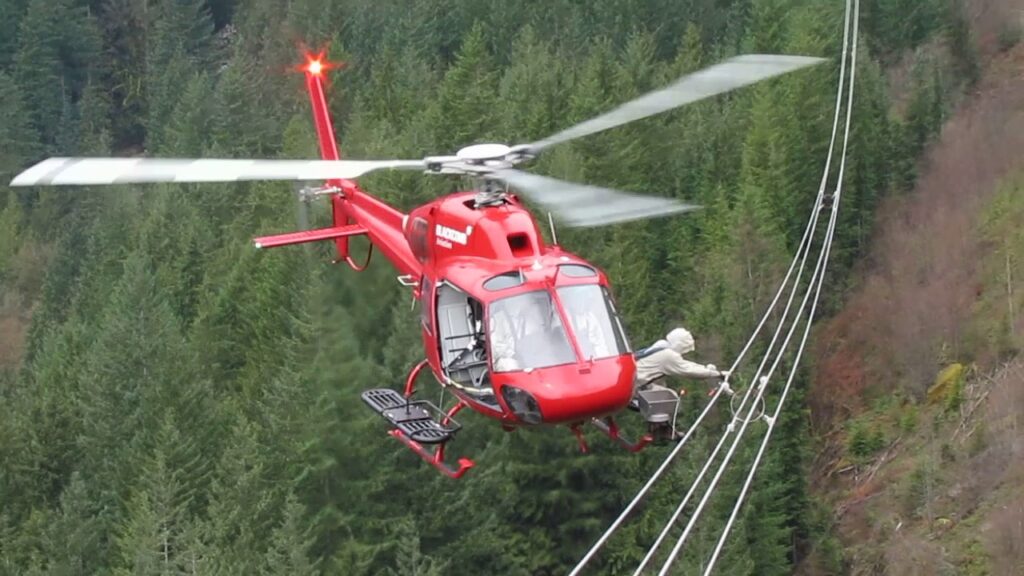Introduction to Helicopter Utility Lifting for Radar Projects
In the vast and varied terrain of Mexico, setting up radar systems often presents a series of logistical challenges. Steep mountains, dense forests, and remote desert areas are common hurdles when transporting and installing heavy radar equipment. This is where helicopter utility lifting comes into play, providing an ingenious solution for positioning radar systems precisely where they are needed. The adaptability of helicopters for aerial transport of loads helps overcome the limitations that conventional ground transportation encounters in difficult terrains.
Helicopter lifting offers unmatched advantages, particularly when it comes to radar projects. The ability to hover and place loads with remarkable accuracy makes helicopters indispensable in the construction and maintenance of radar stations. These flying workhorses are capable of lifting and maneuvering radar components, including antennas, transmitters, and even prefabricated structures to elevated or secluded sites. With the help of skilled pilots and ground coordinators, each lift is executed with precision and care, ensuring the safety and integrity of the equipment.
Today’s technology also allows for real-time monitoring and communication during the lifting process, which adds an additional layer of safety and efficiency. State-of-the-art navigation systems and high-definition cameras enable pilots and engineers to work in concert for the seamless installation of radar systems. This synergy between man, machine, and technology is particularly essential in Mexico, given the country’s challenging landscapes and the importance of establishing a robust radar network for both national security and weather monitoring purposes.
Understanding the technical aspects of helicopter utility lifting is crucial for project managers and engineers working on radar installation projects. Factors such as weight distribution, wind conditions, altitude, and temperature all play significant roles in the planning and execution of a helicopter lift. Tailoring the logistics to the specific needs of the radar equipment and the local environment ensures a successful operation. Through careful coordination and the use of specialized equipment, helicopter lifting has revolutionized the way radar systems are deployed across Mexico’s diverse topography.
The Significance of Batteries in Radar Operations on Coronado Islands
The Coronado Islands, a small archipelago off the coast of Baja California, Mexico, have become a strategic point for monitoring Pacific maritime routes. At the heart of this surveillance system lies the technology of radar operations, which are crucial for detecting and tracking vessels within the vicinity. Integral to these radar systems are the batteries that power them, often overlooked yet essential components. Ensuring a constant, reliable power source is paramount for the uninterrupted function of radar systems and, by extension, the safety and security of Mexican territorial waters.
Radar systems on the Coronado Islands need to be operationally ready at all times. This readiness is partially achieved through the use of high-capacity, durable batteries capable of withstanding the challenging maritime environment. With salty sea air, high humidity, and variable temperatures, the batteries utilized in this setting must be resistant to corrosion, capable of maintaining charge over long periods, and quickly rechargeable to ensure minimal downtime during maintenance or unexpected power interruptions.
The importance of batteries extends to the ecological aspect of operations on the islands. Given the sensitive nature of the local ecosystem, it is imperative that the radar installations have a minimal environmental footprint. This is where the technological advancements in battery design come into play. Modern batteries are not only more efficient but also less prone to leakage and contamination, which aligns with the environmental standards necessary for preservation efforts on the Coronado Islands.
Moreover, the strategic value of the radar facilities on the Coronado Islands necessitates a power source that is both dependable and stealthy. High-quality batteries provide a silent energy reservoir that ensures the radar can operate without generating noise that could reveal its location to potential adversaries. This silent operation is crucial for maintaining the element of surprise and the effectiveness of maritime surveillance undertaken by Mexico in this significant region.
Logistics of Helicopter Battery Transportation to Scripps Radar Station
Transporting helicopter batteries to remote locations such as the Scripps Radar Station in Mexico presents a unique set of logistical challenges that must be carefully navigated. The nature of these batteries, often being large, heavy, and classified as hazardous materials due to their chemical composition, requires precision in planning and execution. Ensuring safety and compliance with regulatory standards is paramount throughout the transit process from the point of origin to the Radar Station’s high-altitude location.
One of the primary considerations when moving helicopter batteries over such distances is the selection of transport routes. The terrain leading up to the Scripps Radar Station is rugged and, in some places, inaccessible by standard road vehicles. Helicopters themselves sometimes become the most viable mode of transportation for their own batteries. This method, while efficient in bypassing terrestrial obstacles, necessitates careful weight and balance calculations to maintain flight safety and performance.
Upon reaching the vicinity of the Radar Station, the team in charge must employ precise drop-off techniques. This often involves coordinating with ground crews proficient in handling hazardous materials. The use of specialized equipment to offload the batteries safely, without causing damage or environmental harm, is critical. The operation often hinges on the time of day and weather conditions, which can rapidly change at high altitudes and impact the ability to safely deliver the batteries.
Packaging and preservation of the batteries throughout the journey is another focal point. Vibration dampening materials and secure anchoring systems are implemented to protect the batteries from damage caused by turbulence or sudden movements during flight. Additionally, temperature control measures are taken to preserve the optimal charge and lifespan of the batteries, which can be sensitive to the extreme temperature variances encountered during transport to such a unique location.
Finally, the helicopter battery transport process involves comprehensive risk management strategies. This includes contingency planning for emergency scenarios, such as an unplanned change in weather or mechanical issues with the transport helicopter. Continuous communication between pilots, logistics coordinators, and the radar station personnel ensures that any issues can be identified and addressed promptly, minimizing potential delays or hazards associated with the transportation of helicopter batteries to the Scripps Radar Station.
Addressing the Challenges of Remote Aerial Lifts in Mexico
In Mexico, providing aerial lift services in remote and rugged terrains presents a unique set of challenges. Helicopter operations in regions like the Sierra Madre or the Yucatan Peninsula encounter not only physical barriers but also logistical ones. The absence of proper infrastructure – landing pads or maintenance facilities – demands innovative solutions and thorough planning to ensure safe and efficient flights.
Another critical aspect that operators face is the climatic variability. Unpredictable weather patterns in Mexico, especially during the rainy season, can abruptly change flight conditions, making it difficult for helicopters to perform lifts or transport operations. Pilots and support teams have to be highly skilled in navigation and prepared to adjust plans at a moment’s notice, to maintain safety as the paramount priority.
From a regulatory standpoint, getting permission to fly in certain areas can be complicated. Protected natural reserves, archaeological sites, and military zones require special permits. Operators must maneuver through a labyrinth of government bureaucracy, which can be time-consuming and requires detailed knowledge of federal and regional aviation laws.
The financial aspect of remote aerial lifts cannot be ignored either. The cost of operation in distant and inaccessible locations is significantly higher. Expenses related to fuel, transportation of equipment, and personnel must all be considered. Additionally, providing adequate insurance coverage in the face of elevated risks represents a considerable challenge for helicopter operators in Mexico.
Advancements in Helicopter Lifting Techniques for Radar Installations
As the demand for sophisticated radar systems increases across Mexico, advancements in helicopter lifting techniques have become pivotal for the installation of these complex pieces of equipment in remote and challenging locations. Unlike traditional methods that often involve large cranes and significant manpower, modern helicopter lifts offer an innovative solution that simplifies the process and reduces the time and labor involved. These aerial feats are executed with precision, thanks to improvements in lift capacity, GPS navigation, and real-time monitoring systems, ensuring a swift and secure placement of radar systems.
Helicopter lifting techniques have benefited greatly from technological progress in avionics and lift mechanisms. Pilots and engineers now have access to enhanced flight stabilization features and load balancing technologies that ensure a safe and efficient lift. For instance, new synthetic rope materials, which are lighter and stronger than their predecessors, allow for an increased payload capacity and reduce the risk of accidents during transit. The integration of advanced communication systems between ground teams and pilots ensures seamless coordination crucial for the meticulous placement of radar antennas.
Furthermore, the implementation of smart technologies, such as drones equipped with cameras, has significantly improved on-site survey capabilities. Drones can scout the installation site, providing essential data that helps in planning the lift and identifying potential obstacles. This contributes to minimizing risks and optimizing the flight path. These advancements not only facilitate the meticulous installation work but also improve safety for both the ground crews and pilots, all while preserving the integrity of the delicate radar equipment. The adoption of these innovative helicopter lifting techniques is transforming the landscape of radar installation in Mexico, promising a new era of agility and precision in the deployment of essential technology.
Ensuring Safety during Helicopter Utility Operations on Coronado Islands
Safety is paramount when conducting helicopter utility operations, particularly in sensitive areas like the Coronado Islands in Mexico. These islands, with their unique landscapes and wildlife, present specific challenges that require careful planning and execution of helicopter missions. Whether they involve transport, construction or maintenance tasks, strict adherence to safety protocols is a must to safeguard both personnel and the delicate ecological balance of the islands.
Before undertaking any helicopter activity in the area, pilots and crews are thoroughly briefed on the unique topographical features and weather patterns of the Coronado Islands. Understanding these environmental conditions is crucial for navigation and operational planning. Weather conditions, such as fog and strong winds, can change rapidly, making real-time communication and decision-making capabilities essential for any crew flying in the vicinity.
All helicopter utility operations around the Coronado Islands adhere to stringent regulations set forth by Mexican aviation authorities. These include no-fly zones to protect sensitive ecosystems, and specific altitude requirements to minimize disturbances to the local wildlife, especially the nesting birds. Crews are trained to recognize these no-fly zones and are always on the lookout for wildlife to avoid disturbances.
Frequent drills and emergency exercises are an integral aspect of maintaining a high safety standard. In the event of mechanical failure or other emergencies, pilots must be able to rely on their training to execute safe landings and minimize the impact on the environment. Emergency response protocols are in place, involving coordination with local conservation and rescue authorities to ensure an effective and timely response.
Maintenance of the helicopters used in operations on the Coronado Islands is another critical factor in ensuring safety. Regular, rigorous checks of all mechanical systems, along with thorough pre-flight inspections, are mandatory. High standards of maintenance reduce the risk of equipment failure and operational errors, thereby protecting both the crew and the sensitive island ecosystem they work within.


